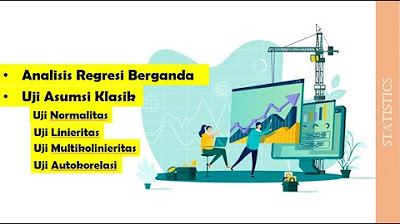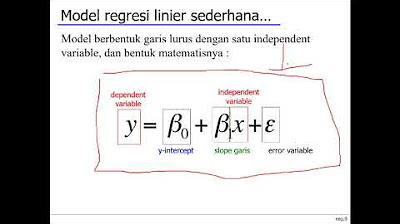What are the main Assumptions of Linear Regression? | Top 5 Assumptions of Linear Regression
Summary
TLDRIn this educational YouTube video, the host covers the crucial topic of 'Assumptions of Linear Regression', a common interview question often misunderstood. The discussion includes five main assumptions: linearity between input and output, no multicollinearity, homoscedasticity, normality, and independence of errors. The host not only explains these concepts theoretically but also demonstrates how to test for them using Python. The video is designed to help viewers understand and detect these assumptions in their data analysis, ensuring more accurate and reliable regression models.
Takeaways
- 😀 The video discusses the importance of understanding linear regression and its assumptions, focusing on the 'Five Assumptions of Linear Regression'.
- 🔍 The presenter emphasizes that a clear linear relationship between the input and output variables is crucial for linear regression models to be effective.
- 📊 The video explains the concept of 'multicollinearity', which is when two or more input variables are highly correlated, and how it can negatively impact the regression model.
- 📈 The presenter uses graphs and plots to illustrate the linear relationships and the potential issues with multicollinearity, helping viewers visually understand the concepts.
- 🧐 The video stresses the need for input variables to be independent of each other, as dependency can lead to misleading interpretations of the regression coefficients.
- 📉 The script mentions the use of Python for detecting multicollinearity through the calculation of variance inflation factors (VIFs) and visual inspection of correlation matrices.
- 📝 The presenter advises on how to interpret residual plots to check for normal distribution of errors, which is another assumption of linear regression.
- 📋 The video provides practical examples and scenarios to help viewers grasp the theoretical concepts, such as the contribution of scientists to a project.
- ✅ The importance of proper model evaluation is highlighted, with the presenter demonstrating how to assess model fit and the distribution of residuals.
- 🔗 The script concludes with a reminder of the key takeaways, reinforcing the importance of understanding and checking the assumptions of linear regression for reliable modeling.
Q & A
What is the main topic covered in the video?
-The main topic covered in the video is 'Assumptions of Linear Regression', focusing on important concepts that are often asked in interviews but frequently not answered properly.
What are the five main assumptions discussed in the video?
-The five main assumptions discussed are: 1) Linear Relationship between Input and Output, 2) Multiple Collinearity, 3) Normality of Residuals, 4) Independence of Errors, and 5) No Autocorrelation.
How does the presenter demonstrate the application of Linear Regression?
-The presenter demonstrates the application of Linear Regression by applying it to a dataset they have created, which represents a scenario of wage data, and then explains the process step by step.
What is meant by 'Linear Relationship' in the context of the video?
-In the context of the video, 'Linear Relationship' refers to a clear or short off linear relationship between the input (independent variables) and the output (dependent variable), which is essential for the accuracy of linear regression models.
What is 'Multiple Collinearity' and why is it a concern in regression analysis?
-Multiple Collinearity occurs when two or more independent variables in a regression model are highly correlated, meaning one can be linearly predicted from the others with a substantial degree of accuracy. It is a concern because it makes it difficult to estimate the individual effects of the correlated variables on the dependent variable.
How can one check for the presence of 'Multiple Collinearity' in their data?
-One can check for 'Multiple Collinearity' by using techniques such as calculating the variance inflation factor (VIF) for each independent variable, or by visually inspecting scatter plots of the independent variables to look for patterns that suggest a high degree of correlation.
What does the presenter mean by 'Normality of Residuals'?
-The presenter refers to the assumption that the residuals (the differences between the observed values and the values predicted by the regression model) should be normally distributed. This is important for the validity of statistical inferences such as hypothesis testing.
How does the presenter suggest testing the 'Independence of Errors' assumption?
-The presenter suggests plotting the residuals against the predicted values to visually inspect for any patterns. If the residuals appear random without any discernible pattern, it suggests that the errors are independent.
What is the implication of 'No Autocorrelation' in the context of linear regression?
-The 'No Autocorrelation' assumption implies that the residuals should not be correlated with each other. If there is autocorrelation, it suggests that the model may omit important variables or that the relationship between variables is not adequately captured by the model.
How can one visually determine if their residuals are normally distributed according to the video?
-One can visually determine if their residuals are normally distributed by creating a histogram or a Q-Q plot of the residuals. If the residuals are normally distributed, the histogram should show a bell-shaped curve, and the Q-Q plot should show points roughly following a straight line.
What is the advice given in the video for dealing with non-normality of residuals?
-The advice given in the video for dealing with non-normality of residuals is to either transform the dependent variable or to use robust regression techniques that are less sensitive to violations of this assumption.
Outlines

Этот раздел доступен только подписчикам платных тарифов. Пожалуйста, перейдите на платный тариф для доступа.
Перейти на платный тарифMindmap

Этот раздел доступен только подписчикам платных тарифов. Пожалуйста, перейдите на платный тариф для доступа.
Перейти на платный тарифKeywords

Этот раздел доступен только подписчикам платных тарифов. Пожалуйста, перейдите на платный тариф для доступа.
Перейти на платный тарифHighlights

Этот раздел доступен только подписчикам платных тарифов. Пожалуйста, перейдите на платный тариф для доступа.
Перейти на платный тарифTranscripts

Этот раздел доступен только подписчикам платных тарифов. Пожалуйста, перейдите на платный тариф для доступа.
Перейти на платный тарифПосмотреть больше похожих видео

KULIAH STATISTIK - ANALISIS REGRESI

Assumptions of Linear Regression | What are the assumptions for a linear regression model

(1/4) Analisis Regresi : Uji asumsi Klasik

Week 6 Statistika Industri II - Analisis Regresi (part 1)

Cara Menghitung Analisis Regresi Sederhana secara Manual

Konsep Dasar Regresi Logistik
5.0 / 5 (0 votes)
